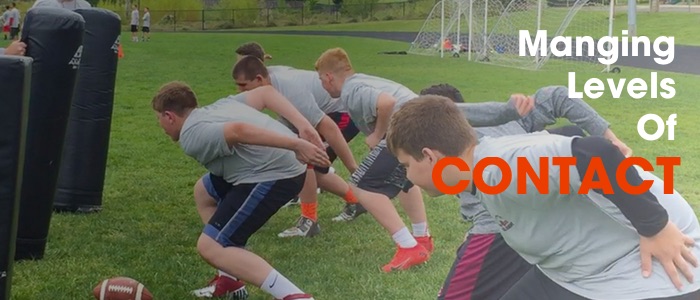Minimize Practice Injuries in Youth Football by Managing Contact

Coaching football requires a bit of a dance when it comes to managing contact: too little contact and the players will not be ready for game speed and game levels of contact. They might be shell-shocked during their first game. Too much contact, and you are risking the same kinds of serious injuries all too common during live games.
My own approach to this has evolved over the years, and what I do closely resembles the Levels of Contact guidance promoted by USA Football. This guidance plus their proposed guidelines for practice are great resources, but I think I have something to add to the conversation. Specifically, I like to follow a very specific flow through the season of contact.
Here’s a brief summary of the levels of contact:
- AIR – running drills unopposed with no contact
- BAGS – running drills against bags, tackling dummies, shields, etc.
- CONTROL – player on player drills with limited contact and a pre-determined “winner”. For example, in a 1 on 1 blocking drill you may say “offense wins” which means the defender puts up resistance but does not compete to win the drill.
- THUD – running competitive drills with no pre-determined winner, but contact stops before a player is brought to the ground. This is when you use a quick whistle.
- LIVE ACTION – this is a game-like situation with no pre-determined winner and full tackling to the ground.
A given week of practice might have all of these elements, but I think the ratios change quite a bit as the season progresses. This is the framework I like to use in a given season.
Early Season / Camp
Our youth league requires at least a full week of non-contact (no pads) before players progress into contact. I like this approach, and if you start earlier in the summer than we do (which is early August) you might even extend this to two or three weeks. Mapping this to the levels of contact above, you would be limiting contact to AIR and BAGS.
Installation Period During Pre-Season
Once players are suited up and you are installing your offense and defense, you will start introducing contact. Even though you will be working towards live action, you should take things slowly and work through the progression. Because you’ve already been doing drills on air and with bags, you should be ready right away for CONTROL based drills. This is a great time to start introducing some of the Seahawks tackling drills. As you move towards some team scrimmaging, you might evolve the contact to THUD level.
Final Pre-Season Refinement
About one week to 10 days before our first game, we finally introduce some LIVE ACTION contact. The players need to understand what game speed and game contact look and feel like before their first game. By now you’ve worked them up the contact pyramid and they should be ready for this.
Live action may take the form of team scrimmage (though don’t consume too much valuable practice time with this!), half-line running game, open field tackling for defensive backs and linebackers, etc.
First Half of Season
I think there’s value in continuing with live action level drills during the first half of the season, but I also would always taper this as each week goes by. For example, during the first two weeks of the season you might still run competitive full tackling drills and some full team scrimmage. Gradually you shift the scrimmage action to THUD level with very quick whistles.
Pay attention to the players and the team as you fine tune this. Too much contact during practice can wear the kids out, increase practice injuries, and even take away their appetite for “real” contact during their weekly game. Keep them hungry and healthy.
Final Half of Season
During the back half of the season, I take away live action contact and even limit the amount of thud contact. My opinion here is that if the players and team aren’t prepared for contact by now, they probably won’t get there by season end. They should be doing fine by now if you’ve gradually introduced contact. So there are diminishing returns in continuing with high levels of practice contact, and your practice plans should reflect this.
Earlier in my coaching career when I started implementing this model, I got plenty of grief from other coaches and even parents. If we had a poor defensive showing in a game and during the prior week there had been limited contact, I was sure to hear chirping from the sidelines about how the kids aren’t hitting enough, we should be scrimmaging more, etc. Stick to your guns – there’s a right time for the right level of contact, and if you monitor performance throughout the season you can dial it up or down as needed.